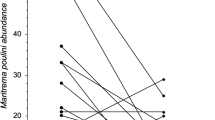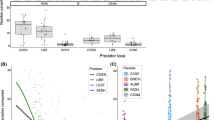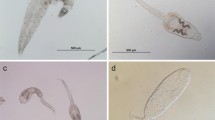Abstract
Parasites often alter host physiology and behavior, which can enhance predation risk for infected hosts. Higher consumption of parasitized prey can in turn lead to a less parasitized prey population (the healthy herd hypothesis). Loxothylacus panopaei is a non-native castrating barnacle parasite on the mud crab Eurypanopeus depressus along the Atlantic coast. Through prey choice mesocosm experiments and a field tethering experiment, we investigated whether the predatory crab Callinectes sapidus and other predators preferentially feed on E. depressus infected with L. panopaei. We found that C. sapidus preferentially consumed infected E. depressus 3 to 1 over visibly uninfected E. depressus in the mesocosm experiments. Similarly, infected E. depressus were consumed 1.2 to 1 over uninfected conspecifics in field tethering trials. We evaluated a mechanism behind this skewed prey choice, specifically whether L. panopaei affects E. depressus movement, making infected prey more vulnerable to predator attack. Counter to our expectations, infected E. depressus ran faster during laboratory trials than uninfected E. depressus, suggesting that quick movement may not decrease predation risk and seems instead to make the prey more vulnerable. Ultimately, the preferential consumption of L. panopaei-infected prey by C. sapidus highlights how interactions between organisms could affect where novel parasites are able to thrive.




Similar content being viewed by others
References
Andrews JD (1980) A review of introductions of exotic oysters and biological planning for new importations. Mar Fish Rev 42:1–11
Beck MW (1995) Size-specific shelter limitation in stone crabs: a test of the demographic bottleneck hypothesis. Ecology 76:968–980. doi:10.2307/1939360
Cáceres CE, Knight CJ, Hall SR (2009) Predator-spreaders: predation can enhance parasite success in a planktonic host–parasite system. Ecology 90:2850–2858. doi:10.1890/08-2154.1
Chakraborty S, Kooi BW, Biswas B, Chattopadhyay J (2015) Revealing the role of predator interference in a predator–prey system with disease in prey population. Ecol Complex 21:100–111. doi:10.1016/j.ecocom.2014.11.005
Cruz A, Manolis T, Wiley JW (1985) The shiny cowbird: a brood parasite expanding its range in the Caribbean region. Ornithol Monogr 36:607–620. doi:10.2307/40168308
Cudmore TJ, Björklund N, Carroll AL, Staffan Lindgren B (2010) Climate change and range expansion of an aggressive bark beetle: evidence of higher beetle reproduction in naïve host tree populations. J Appl Ecol 47:1036–1043. doi:10.1111/j.1365-2664.2010.01848.x
deRivera CE, Ruiz GM, Hines AH, Jivoff P (2005) Biotic resistance to invasion: native predator limits abundance and distribution of an introduced crab. Ecology 86:3364–3376. doi:10.1890/05-0479
Duffy MA (2007) Selective predation, parasitism, and trophic cascades in a bluegill–Daphnia—parasite system. Oecologia 153:453–460. doi:10.1007/s00442-007-0742-y
Duffy MA, Hall SR, Tessier A, Huebner M (2005) Selective predators and their parasitized prey: are epidemics in zooplankton under top–down control? Limnol Oceanogr 50:412–420. doi:10.4319/lo.2005.50.2.0412
Duffy MA, Housley JM, Penczykowski RM, Cáceres CE, Hall SR (2011) Unhealthy herds: indirect effects of predators enhance two drivers of disease spread. Funct Ecol 25:945–953. doi:10.1111/j.1365-2435.2011.01872.x
Dunn AM, Hatcher MJ (2015) Parasites and biological invasions: parallels, interactions, and control. Trends Parasitol 31:189–199. doi:10.1016/j.pt.2014.12.003
Dunn AM, Torchin ME, Hatcher MJ, Kotanen PM, Blumenthal DM, Byers JE, Coon CAC, Frankel VM, Holt RD, Hufbauer RA, Kanarek AR, Schierenbeck KA, Wolfe LM, Perkins SE (2012) Indirect effects of parasites in invasions. Funct Ecol 26:1262–1274. doi:10.1111/j.1365-2435.2012.02041.x
Eash-Loucks WE, Kimball ME, Petrinec KM (2014) Long-term changes in an estuarine mud crab community: evaluating the impact of non-native species. J Crustac Biol 34:731–738. doi:10.1163/1937240X-00002287
Fassbinder-Orth CA, Barak VA, Brown CR (2013) Immune responses of a native and an invasive bird to buggy creek virus (Togaviridae: Alphavirus) and its arthropod vector, the swallow bug (Oeciacus vicarius). PLoS One 8:e58045. doi:10.1371/journal.pone.0058045
Freeman AS, Blakeslee AMH, Fowler AE (2013) Northward expansion of the rhizocephalan Loxothylacus panopaei (Gissler, 1884) in the Northwest Atlantic. Aquat Invasions 8:347–353. doi:10.3391/ai.2013.8.3.11
Garner TWJ, Perkins MW, Govindarajulu P, Seglie D, Walker S, Cunningham AA, Fisher MC (2006) The emerging amphibian pathogen Batrachochytrium dendrobatidis globally infects introduced populations of the North American bullfrog, Rana catesbeiana. Biol Lett 2:455–459. doi:10.1098/rsbl.2006.0494
Gehman AM, Grabowski JH, Hughes AR, Kimbro DL, Piehler MF, Byers JE (2016) Predators, environment and host characteristics influence the probability of infection by an invasive castrating parasite. Oecologia. doi:10.1007/s00442-016-3744-9
Hatcher MJ, Dick JTA, Dunn AM (2012) Disease emergence and invasions. Funct Ecol 26:1275–1287. doi:10.1111/j.1365-2435.2012.02031.x
Hemmi JM, Pfeil A (2010) A multi-stage anti-predator response increases information on predation risk. J Exp Biol 213:1484–1489. doi:10.1242/jeb.039925
Hethcote HW, Wang W, Han L, Ma Z (2004) A predator–prey model with infected prey. Theor Popul Biol 66:259–268. doi:10.1016/j.tpb.2004.06.010
Higgins JPT, Thompson SG (2002) Quantifying heterogeneity in a meta-analysis. Stat Med 21:1539–1558. doi:10.1002/sim.1186
Hines AH, Alvarez F, Reed S (1997) Introduced and native populations of a marine parasitic castrator: variation in prevalence of the rhizocephalan Loxothylacus panopaei in xanthid crabs. Bull Mar Sci 61:197–214
Hoeg JT (1995) The biology and life cycle of the rhizocephala (cirripedia). J Mar Biol Ass UK 75:517–550
Hudson PJ, Dobson A, Newborn D (1992) Do parasites make prey vulnerable to predation? red grouse and parasites. J Anim Ecol 61:681–692
Hulathduwa YD, Stickle WB, Aronhime B, Brown KM (2011) Differences in refuge use are related to predation risk in estuarine crabs. J Shellfish Res 30:949–956. doi:10.2983/035.030.0337
Krkosek M, Connors BM, Ford H, Peacock S, Mages P, Ford JS, Morton A, Volpe JP, Hilborn R, Dill LM, Lewis MA (2011) Fish farms, parasites, and predators: implications for salmon population dynamics. Ecol Appl 21:897–914. doi:10.1890/09-1861.1
Kruse HH, Hare MP (2007) Genetic diversity and expanding nonindigenous range of the rhizocephalan Loxothylacus panopaei parasitizing mud crabs in the Western North Atlantic. J Parasitol 93:575–582. doi:10.1645/GE-888R.1
Kruse HH, Hare MP, Hines AH (2011) Genetic relationships of the marine invasive crab parasite Loxothylacus panopaei: an analysis of DNA sequence variation, host specificity, and distributional range. Biol Invasions 14:701–715. doi:10.1007/s10530-011-0111-y
Levine JM, D’Antonio CM (2003) Forecasting biological invasions with increasing international trade. Conserv Biol 17:322–326. doi:10.1046/j.1523-1739.2003.02038.x
Lymbery AJ, Morine M, Kanani HG, Beatty SJ, Morgan DL (2014) Co-invaders: the effects of alien parasites on native hosts. Int J Parasitol 3:171–177. doi:10.1016/j.ijppaw.2014.04.002
Mack RN, Simberloff D, Lonsdale WM, Evans H, Clout M, Bazzaz FA (2000) Biotic invasions: causes, epidemiology, global consequences, and control. Ecol Appl 10:689–710. doi:10.1890/1051-0761(2000)010[0689:BICEGC]2.0.CO;2
McLennan JA, Dew L, Miles J, Gillingham N, Waiwai R (2004) Size matters: predation risk and juvenile growth in North Island brown kiwi (Apteryx mantelli). N Z J Ecol 28:241–250. doi:10.2307/24056435
Meyer D (1994) Habitat partitioning between the xanthid crabs Panopeus herbstii and Eurypanopeus depressus on intertidal oyster reefs (Crassostrea virginica) in Southeastern North Carolina. Estuaries Coast 17:674–679
Noonburg EG, Byers JE (2005) More harm than good: when invader vulnerability to predators enhances impact on native species. Ecology 86:2555–2560. doi:10.1890/05-0143
O’Shaughnessy KA, Harding JM, Burge EJ (2014) Ecological effects of the invasive parasite Loxothylacus panopaei on the flatback mud crab Eurypanopeus depressus with implications for estuarine communities. Bull Mar Sci 90:611–621. doi:10.5343/bms.2013.1060
Packer C, Holt RD, Hudson PJ, Lafferty KD, Dobson AP (2003) Keeping the herds healthy and alert: implications of predator control for infectious disease. Ecol Lett 6:797–802. doi:10.1046/j.1461-0248.2003.00500.x
Paine R (1976) Size-limited predation: an observational and experimental approach with the mytilus–pisaster interaction. Ecology 57:858–873
Peacock SJ, Connors BM, Krkosek M, Irvine JR, Lewis MA (2014) Can reduced predation offset negative effects of sea louse parasites on chum salmon? Proc R Soc B 281:20132913. doi:10.1098/rspb.2013.2913
R Development Core Team (2015) R: a language and environment for statistical computing. R Foundation for Statistical Computing, Vienna, Austria. Availabe at: https://www.R-project.org/
Reinhard E, Reischman P (1958) Variation in Loxothylacus panopaei (Gissler), a common Sacculinid parasite of mud crabs, with the description of Loxothylacus perarmatus, n. sp. J Parasitol 44:93–97
Schwalbe MAB, Bassett DK, Webb JF (2012) Feeding in the dark: lateral-line-mediated prey detection in the peacock cichlid Aulonocara stuartgranti. J Exp Biol 215:2060–2071. doi:10.1242/jeb.065920
Shervette VR, Perry HM (2004) Factors influencing refuge occupation by stone crab Menippe adina juveniles in Mississippi Sound. J Crustac Biol 24:652–665. doi:10.1651/c-2453
Sih A (1982) Optimal patch use: variation in selective pressure for efficient foraging. Am Nat 120:666–685. doi:10.1086/284019
Somers MJ, Nel JAJ (1998) Dominance and population structure of freshwater crabs (Potamonautes perlatus Milne Edwards). S Afr J Zool 33:31–36. doi:10.1080/02541858.1998.11448450
Toscano BJ, Newsome B, Griffen BD (2014) Parasite modification of predator functional response. Oecologia 175:345–352. doi:10.1007/s00442-014-2905-y
Van Engel W, Dillon WA, Zwerner D, Eldridge D (1966) Loxothylacus Panopaei (cirripedia, sacculinidae) an introduced parasite on a xanthid crab in Chesapeake Bay, USA. Crustaceana 10:110–112
Welch KD, Harwood JD (2011) Predator–pathogen interactions: synergy between mortality causes and failure of the healthy herds hypothesis. Funct Ecol 25:943–944. doi:10.1111/j.1365-2435.2011.01906.x
Wieters EA, Gaines SD, Navarrete SA, Blanchette CA, Menge BA (2008) Scales of dispersal and the biogeography of marine predator–prey interactions. Am Nat 171:405–417. doi:10.1086/527492
Wild M, Thompson Hobbs N, Graham M, Miller M (2011) The role of predation in disease control: a comparison of selective and nonselective removal on prion disease dynamics in deer. J Wildl Dis 47:78–93. doi:10.7589/0090-3558-47.1.78
Acknowledgements
We thank A. Penn, S. Perry, R. Smith, Z. Holmes, A. Calfee, and R. Usher for field and laboratory assistance. We thank the Byers and Osenberg laboratories for discussion. We thank J. Porter, S. Altizer, V. Ezenwa, and W. Fitt for valuable guidance. We thank Jonathan Little, Kevin Ruddell, Heather Kroll, and 30 other supporters for significant support of this research through the SciFund Challenge. Support also came from the Odum School of Ecology. The lead author was a fellow with the Wormsloe Institute for Environmental History.
Author contribution statement
AMG and JEB conceived and designed the experiments and wrote the manuscript; AMG conducted the experiments and analyzed the data.
Author information
Authors and Affiliations
Corresponding author
Ethics declarations
Ethical approval
All applicable institutional and/or national guidelines for the care and use of animals were followed.
Conflict of interest
The authors declare that they have no conflict of interest.
Additional information
Communicated by Joel Trexler.
We found preferential consumption of native hosts infected by invasive parasites, highlighting how interactions between organisms can affect where novel parasites are able to establish and survive.
Rights and permissions
About this article
Cite this article
Gehman, AL.M., Byers, J.E. Non-native parasite enhances susceptibility of host to native predators. Oecologia 183, 919–926 (2017). https://doi.org/10.1007/s00442-016-3784-1
Received:
Accepted:
Published:
Issue Date:
DOI: https://doi.org/10.1007/s00442-016-3784-1




